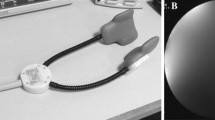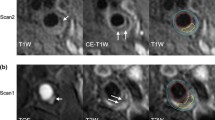Abstract
Vulnerable plaques have thin fibrous caps overlying large necrotic lipid cores. Recent studies have shown that high-resolution MR imaging can identify these components. We set out to determine whether in vivo high-resolution MRI could quantify this aspect of the vulnerable plaque. Forty consecutive patients scheduled for carotid endarterectomy underwent pre-operative in vivo multi-sequence MR imaging of the carotid artery. Individual plaque constituents were characterised on MR images. Fibrous-cap and lipid-core thickness was measured on MRI and histology images. Bland-Altman plots were generated to determine the level of agreement between the two methods. Multi-sequence MRI identified 133 corresponding MR and histology slices. Plaque calcification or haemorrhage was seen in 47 of these slices. MR and histology derived fibrous cap–lipid-core thickness ratios showed strong agreement with a mean difference between MR and histology ratios of 0.02 (±0.04). The intra-class correlation coefficient between two readers for measurements was 0.87 (95% confidence interval, 0.73 and 0.93). Multi-sequence, high-resolution MR imaging accurately quantified the relative thickness of fibrous-cap and lipid-core components of carotid atheromatous plaques. This may prove to be a useful tool to characterise vulnerable plaques in vivo.



Similar content being viewed by others
References
Yuan C, Mitsumori LM, Beach KW, Maravilla KR (2001) Carotid atherosclerotic plaque: noninvasive MR characterization and identification of vulnerable lesions. Radiology 221:285–299
Stary HC, Chandler AB, Dinsmore RE, Fuster V, Glagov S, Insull W Jr, Rosenfeld ME, Schwartz CJ, Wagner WD, Wissler RW (1995) A definition of advanced types of atherosclerotic lesions and a histological classification of atherosclerosis. A report from the Committee on Vascular Lesions of the Council on Arteriosclerosis, American Heart Association. Circulation 92:1355–1374
Virmani R, Burke AP, Kolodgie FD, Farb A (2002) Vulnerable plaque: the pathology of unstable coronary lesions. J Interv Cardiol 15:439–446
Yuan C, Mitsumori LM, Ferguson MS, Polissar NL, Echelard D, Ortiz G, Small R, Davies JW, Kerwin WS, Hatsukami TS (2001). In vivo accuracy of multispectral magnetic resonance imaging for identifying lipid-rich necrotic cores and intraplaque hemorrhage in advanced human carotid plaques. Circulation 104:2051–2056
Yuan C, Beach KW, Smith LH Jr, Hatsukami TS (1998) Measurement of atherosclerotic carotid plaque size in vivo using high resolution magnetic resonance imaging. Circulation 98:2666–2671
Luo Y, Polissar N, Han C, Yarnykh V, Kerwin WS, Hatsukami TS, Yuan C (2003) Accuracy and uniqueness of three in vivo measurements of atherosclerotic carotid plaque morphology with black blood MRI. Magn Reson Med 50:75–82
U-King-Im J, Graves MJ, Kirkpatrick PJ, Gillard JH (2003) Limitations of high-resolution black-blood cross-sectional magnetic resonance imaging in the assessment of carotid stenosis. Stroke 34:258 [Abstract]
Kang X, Polissar NL, Han C, Lin E, Yuan C (2000) Analysis of the measurement precision of arterial lumen and wall areas using high-resolution MRI. Magn Reson Med 44:968–972
Virmani R, Kolodgie FD, Burke AP, Farb A, Schwartz SM (2000) Lessons from sudden coronary death: a comprehensive morphological classification scheme for atherosclerotic lesions. Arterioscler Thromb Vasc Biol 20:1262–1275
North American Symptomatic Carotid Endarterectomy Trial Collaborators (1991) Beneficial effect of carotid endarterectomy in symptomatic patients with high-grade carotid stenosis. N Engl J Med 325:445–453
Randomised trial of endarterectomy for recently symptomatic carotid stenosis: final results of the MRC European Carotid Surgery Trial (ECST) (1998) Lancet 351:1379-1387
Executive Committee for the Asymptomatic Carotid Atherosclerosis Study (1995) Endarterectomy for asymptomatic carotid artery stenosis. JAMA 273:1421–1428
Glagov S, Weisenberg E, Zarins CK, Stankunavicius R, Kolettis GJ (1987) Compensatory enlargement of human atherosclerotic coronary arteries. N Engl J Med 316:1371–1375
Coulden RA, Moss H, Graves MJ, Lomas DJ, Appleton DS, Weissberg PL (2000). High resolution magnetic resonance imaging of atherosclerosis and the response to balloon angioplasty. Heart 83:188–191
Hatsukami TS, Ross R, Polissar NL, Yuan C (2000) Visualization of fibrous cap thickness and rupture in human atherosclerotic carotid plaque in vivo with high-resolution magnetic resonance imaging. Circulation 102:959–964
Pasterkamp G, Schoneveld AH, van der Wal AC, Hijnen DJ, van Wolveren WJ, Plomp S, Teepen HL, Borst C (1999) Inflammation of the atherosclerotic cap and shoulder of the plaque is a common and locally observed feature in unruptured plaques of femoral and coronary arteries. Arterioscler Thromb Vasc Biol 19:54–58
Morrisett J, Vick W, Sharma R, Lawrie G, Reardon M, Ezell E, Schwartz J, Hunter G, Gorenstein D (2003) Discrimination of components in atherosclerotic plaques from human carotid endarterectomy specimens by magnetic resonance imaging ex vivo (1). Magn Reson Imaging 21:465–474
Acknowledgements
The study was funded in part by the Stroke Association (UK)
Author information
Authors and Affiliations
Corresponding author
Rights and permissions
About this article
Cite this article
Trivedi, R.A., U-King-Im, JM., Graves, M.J. et al. MRI-derived measurements of fibrous-cap and lipid-core thickness: the potential for identifying vulnerable carotid plaques in vivo. Neuroradiology 46, 738–743 (2004). https://doi.org/10.1007/s00234-004-1247-6
Received:
Accepted:
Published:
Issue Date:
DOI: https://doi.org/10.1007/s00234-004-1247-6




